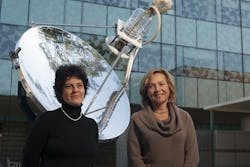Houston, TX--A new technology that uses nanoparticles to convert solar energy directly into steam has been developed by Rice University scientists. This new "solar steam" method from Rice's Laboratory for Nanophotonics (LANP) is so effective it can even produce steam from icy cold water. Published online in ACS Nano, the technology has an overall energy efficiency of 24%—even better than solar photovoltaic panels. Initially, however, the inventors of the solar steam technology say it will be initially used for sanitation and water purification in developing countries rather than for energy generation.
"This is about a lot more than electricity," said LANP director Naomi Halas, lead scientist on the project. "With this technology, we are beginning to think about solar thermal power in a completely different way." The efficiency of solar steam is due to the light-capturing nanoparticles that convert sunlight into heat. When submerged in water and exposed to sunlight, the particles heat up so quickly they instantly vaporize water and create steam. Halas said the solar steam's overall energy efficiency can probably be increased as the technology is refined.
"We're going from heating water on the macro scale to heating it at the nanoscale," Halas said. "Our particles are very small—even smaller than a wavelength of light—which means they have an extremely small surface area to dissipate heat. This intense heating allows us to generate steam locally, right at the surface of the particle, and the idea of generating steam locally is really counterintuitive." Rice graduate student Oara Neumann videotaped a solar steam demonstration in which a test tube of water containing light-activated nanoparticles was submerged into a bath of ice water. Using a lens to concentrate sunlight onto the near-freezing mixture in the tube, Neumann showed she could create steam from nearly frozen water.
Steam is one of the world's most-used industrial fluids and about 90% of electricity is produced from steam, and steam is also used to sterilize medical waste and surgical instruments, to prepare food and to purify water. Most industrial steam is produced in large boilers, and Halas said solar steam's efficiency could allow steam to become economical on a much smaller scale. People in developing countries will be among the first to see the benefits of solar steam. Rice engineering undergraduates have already created a solar steam-powered autoclave that's capable of sterilizing medical and dental instruments at clinics that lack electricity. Halas also won a Grand Challenges grant from the Bill and Melinda Gates Foundation to create an ultra-small-scale system for treating human waste in areas without sewer systems or electricity.
Another potential use could be in powering hybrid air-conditioning and heating systems that run off of sunlight during the day and electricity at night. Halas, Neumann and colleagues have also conducted distillation experiments and found that solar steam is about two-and-a-half times more efficient than existing distillation columns. For cancer treatment technology and many other applications, Halas' team chooses particles that interact with just a few wavelengths of light. For the solar steam project, Halas and Neumann set out to design a particle that would interact with the widest possible spectrum of sunlight energy. Their new nanoparticles are activated by both visible sunlight and shorter wavelengths that humans cannot see.
SOURCE: Rice University; http://news.rice.edu/2012/11/19/rice-unveils-super-efficient-solar-energy-technology/
About the Author

Gail Overton
Senior Editor (2004-2020)
Gail has more than 30 years of engineering, marketing, product management, and editorial experience in the photonics and optical communications industry. Before joining the staff at Laser Focus World in 2004, she held many product management and product marketing roles in the fiber-optics industry, most notably at Hughes (El Segundo, CA), GTE Labs (Waltham, MA), Corning (Corning, NY), Photon Kinetics (Beaverton, OR), and Newport Corporation (Irvine, CA). During her marketing career, Gail published articles in WDM Solutions and Sensors magazine and traveled internationally to conduct product and sales training. Gail received her BS degree in physics, with an emphasis in optics, from San Diego State University in San Diego, CA in May 1986.
